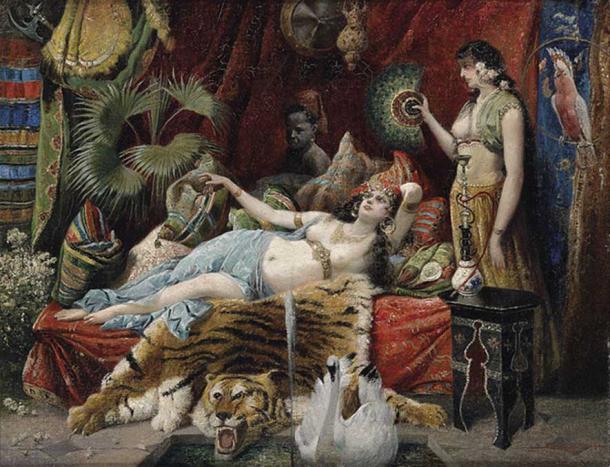
The imperial harem of the Ottoman era was the collection of wives, servants and concubines of the Sultan, who sometimes numbered in the hundreds. Some were mere playthings or used for the production of heirs, while others rose to great power and influence.
The term “harem” brings to mind an image of a room full of beautiful women whose sole purpose in life was to please their captor sexually. This image may have been inspired by the 16 th and 17 th century harems of the Ottoman empire. However, the harem were more than just sexual playthings for the Sultan. Existing between 1299 and 1920 AD, the Ottoman sultan’s harem was comprised of wives,servants, female relatives of the sultan, and concubines. The women in the harem played a much greater role than simply entertaining the sultan, some had a hand in governing the powerful Ottoman empire. A period known as the “Reign of Women” or the Kadinlar Sultanati saw the harem of women playing an important role within the Ottoman government, leading them to gain more power than ever before.

Large Harem, Great Power
The harem was the ultimate symbol of power and wealth of the Sultan. His ownership of women and eunuchs, mostly as slaves, showed his wealth and prowess.
The institution of the harem was introduced in Turkish society with the adoption of Islam, under the influence of the Arab Caliphate which the Ottoman’s sought to emulate.
Most of the men and women within the harem were bought as slaves to ensure obedience, however some remained free. The main wives, especially those married to solidify personal and dynastic alliances were free women. Slaves and free men and women alike were given an education within the harem. At the end of their respective educations, the men and women would be married off to each other. Subsequently, the men would be sent to occupy administrative posts in the empire’s provinces.
Due to this practice, only a small number of women were chosen to become part of the Sultan’s personal harem of concubines. This group of women was governed by the Valide Sultan, typically the Sultan’s own mother. An even smaller number of women would be chosen as the Sultan’s favourites, or the hasekis. Even these women could be chosen to be married off or sent as gifts to valued members of the Ottoman elite, that is if they hadn’t had sexual relations with the Sultan himself.

Dorotheum by Joseph Himmel, 1921. Shows the hierarchy within a harem ( Public Domain )
The First Lady of the Harem
The most powerful woman in the harem, the Valide Sultan, would have been a wife or concubine of the Sultan’s father and would have risen to supreme rank within the harem.
No court lady could leave or enter the premises of the harem without the permission of the Valide Sultan and the eunuchs of the court would answer directly to her. The Valide Sultan was also responsible for the education of her son on the intricacies of state politics. She was also often asked to intervene on her son’s decisions as a member of the imperial court.
The next most powerful women in the harem would be the concubines that rose through the ranks to attain the titles of Gözde (the Favourite), Ikbal (the Fortunate) or Kadın (the Woman/Wife). Traditionally the Sultan could only have these four as his favourites and they had an equivalent rank to the Sultan’s legal wives within the hierarchy of...
